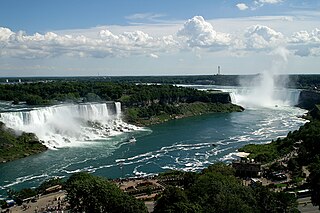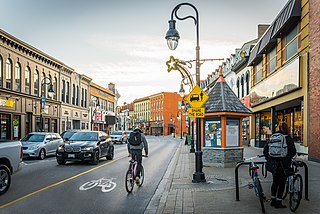Related Research Articles

The Niagara River is a river that flows north from Lake Erie to Lake Ontario. It forms part of the border between the province of Ontario in Canada and the state of New York in the United States. There are differing theories as to the origin of the river's name. According to Iroquoian scholar Bruce Trigger, Niagara is derived from the name given to a branch of the locally residing native Neutral Confederacy, who are described as being called the Niagagarega people on several late-17th-century French maps of the area. According to George R. Stewart, it comes from the name of an Iroquois town called Ongniaahra, meaning "point of land cut in two".

Niagara Falls is a group of three waterfalls at the southern end of Niagara Gorge, spanning the border between the province of Ontario in Canada and the state of New York in the United States. The largest of the three is Horseshoe Falls, which straddles the international border of the two countries. It is also known as the Canadian Falls. The smaller American Falls and Bridal Veil Falls lie within the United States. Bridal Veil Falls is separated from Horseshoe Falls by Goat Island and from American Falls by Luna Island, with both islands situated in New York.

Niagara Falls is a city in Ontario, Canada. It is on the western bank of the Niagara River in the Golden Horseshoe region of Southern Ontario, with a population of 88,071 at the 2016 census. It is part of the St. Catharines - Niagara Census Metropolitan Area (CMA). Incorporated on 12 June 1903, the city is across the river from Niagara Falls, New York. The Niagara River flows over Niagara Falls at this location, creating a natural spectacle which attracts millions of tourists each year.

St. Catharines is the most populous city in Canada's Niagara Region, the eighth largest urban area in the province of Ontario. As of 2017, St. Catherines has an area of 96.13 square kilometres (37.12 sq mi) and 140,370 residents. It lies in Southern Ontario, 51 kilometres (32 mi) south of Toronto across Lake Ontario, and is 19 kilometres (12 mi) inland from the international boundary with the United States along the Niagara River. It is the northern entrance of the Welland Canal. Residents of St. Catharines are known as St. Catharinites. St. Catharines carries the official nickname "The Garden City" due to its 1,000 acres (4 km2) of parks, gardens, and trails.

The Golden Horseshoe is a secondary region of Southern Ontario, Canada, which lies at the western end of Lake Ontario, with outer boundaries stretching south to Lake Erie and north to Lake Scugog, Lake Simcoe and Georgian Bay of Lake Huron. The region is the most densely populated and industrialized in Canada. Based on the 2021 census, with a population of 7,759,635 people in its core and 9,765,188 in its greater area, the Golden Horseshoe accounts for over 20 percent of the population of Canada and more than 54 percent of Ontario's population. It is part of the Quebec City–Windsor Corridor, itself part of the Great Lakes megalopolis.

The Maple Leaf is an international passenger train service operated by Amtrak and Via Rail between Pennsylvania Station in New York City and Union Station in Toronto via the Empire Corridor. Daily service is offered in both directions; the 544-mile (875 km) trip takes approximately 12 hours, including two hours for U.S. or Canadian customs and immigration inspection at either Niagara Falls, New York, or Niagara Falls, Ontario. Although the train uses Amtrak rolling stock exclusively, the train is operated by Via Rail crews while in Canada and by Amtrak crews in the United States. Service began in 1981.

The Regional Municipality of Niagara, also colloquially known as the Niagara Region or Region of Niagara, is a regional municipality comprising twelve municipalities of Southern Ontario, Canada. The regional seat is in Thorold. It is the southern end of the Golden Horseshoe, the largest megalopolis in Canada.

The Shaw Festival is a not-for-profit theatre festival in Niagara-on-the-Lake, Ontario, Canada. It is the second largest repertory theatre company in North America. The Shaw Festival was founded in 1962. Originally, it only featured productions written by George Bernard Shaw, but changes were later implemented by Christopher Newton and Jackie Maxwell that widened the theatre's scope. As of 2019, the theatre company was considered to be one of the largest 20 employers in the Niagara Region.

Julia Verlyn LaMarsh, was a Canadian politician, lawyer, author and broadcaster. In 1963, she was only the second woman to ever serve as a federal Cabinet Minister. Under Prime Minister Lester Pearson's minority governments of the middle and late 1960s, she helped push through the legislation that created the Canada Pension Plan and Medicare. As Secretary of State, she was in charge of Canada's Centennial celebrations in 1967. After leaving politics in 1968, she wrote three books, and had her own radio show on CBC Radio. She was stricken with pancreatic cancer in 1979 and was given the Order of Canada at her hospital bed. She died a few days short of the 20th anniversary of her first political election victory, in 1980.

The Canada Games is a multi-sport event held every two years, alternating between the Canada Winter Games and the Canada Summer Games. They represent the highest level of national competition for Canadian athletes. Two separate programs are organized in order to cover the seasons of summer and winter: the Canada Summer Games (CSG) and the Canada Winter Games (CWG). Athlete age eligibility rules vary. The host cities have not been chosen for the games after 2025 but the provinces through 2035 have been selected.

Navy Island is a small, uninhabited island in the Niagara River in the province of Ontario, managed by Parks Canada as a National Historic Site of Canada. It is located about 4.5 kilometres upstream from Horseshoe Falls, and has an area of roughly 1.2 km2. It is across from the town of Grand Island, New York, US. It was designated a national historic site in 1921 in recognition of its role in shipbuilding and the location of the short-lived Republic of Canada. The site is closed to the public, has no visitor facilities, and has not allowed camping since the expiration of a lease with the Niagara Parks Commission.
Meteor was a marque of automobiles offered by Ford Motor Company of Canada from 1949 to 1976. The make was retired for the 1962 and 1963 model years, when the name was used for the Mercury Meteor sold in the United States. It succeeded the Mercury 114, a Canadian-market Mercury based on the Ford, the "114" name being taken from the car's wheelbase.

George Anton Hinterhoeller (1928–1999) was a Canadian boat designer and builder, a significant contributor to the Canadian sailboat industry for almost forty years.
Timothy H. Rigby is a politician in Ontario, Canada. He served as Mayor of St. Catharines from 1997 to 2006, and is currently a Niagara Regional Councillor.

Sherman Avenue is a collector road in the lower portion of Hamilton, Ontario, Canada. It begins at the Niagara Escarpment just south of Cumberland Avenue and is a one-way street bisecting the industrialized northern neighbourhoods of the city. It ends at Ship Street — the site of Steel Company of Canada (Stelco).

Piccadilly Incident is a 1946 British drama film directed by Herbert Wilcox and starring Anna Neagle, Michael Wilding, Coral Browne, Edward Rigby and Leslie Dwyer. Wilcox teamed his wife Anna Neagle with Michael Wilding for the first time, establishing them as top box-office stars in five more films, ending with The Lady with a Lamp in 1951. Wilding was third choice for leading man after Rex Harrison and John Mills.

The Niagara Purple Eagles are athletics teams that represent Niagara University in college sports. Part of the NCAA's Division I, the Purple Eagles field 19 varsity level teams. The Purple Eagles are members of the Metro Atlantic Athletic Conference and Atlantic Hockey. Between 1946 and 1958, Niagara was a member of the Western New York Little Three Conference.
George Augustus Forneret was a Canadian Anglican priest.
The Canadian and later, Canadian-Niagara, was the longest running named international train from Chicago to Upper Canada via Detroit, for its first two decades running to Montreal. This overnight train was operated by the Michigan Central Railroad from Chicago to Detroit, and in a pool arrangement, it operated over Canadian Pacific Railway tracks and used the same train number from Detroit eastward. The train would carry a second section, bound, variously for Buffalo or New York City via Buffalo.
References
- ↑ Crockford's Clerical Directory 1967-68 p 1051 London: Oxford University Press, 1967